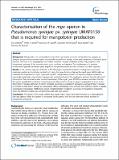Por favor, use este identificador para citar o enlazar a este item:
http://hdl.handle.net/10261/46886COMPARTIR / EXPORTAR:
 SHARE
BASE SHARE
BASE
|
|
| Visualizar otros formatos: MARC | Dublin Core | RDF | ORE | MODS | METS | DIDL | DATACITE | |

| Título: | Characterisation of the mgo operon in Pseudomonas syringae pv. syringae UMAF0158 that is required for mangotoxin production |
Autor: | Arrebola, Eva; Carrión, Víctor J.; Cazorla, Francisco Manuel; Pérez-García, Alejandro; Murillo, Jesús; Vicente, Antonio de | Fecha de publicación: | 17-ene-2012 | Editor: | BioMed Central | Citación: | BMC Microbiology 12(1) : 10- (2012) | Resumen: | Abstract Background Mangotoxin is an antimetabolite toxin that is produced by strains of Pseudomonas syringae pv. syringae; mangotoxin-producing strains are primarily isolated from mango tissues with symptoms of bacterial apical necrosis. The toxin is an oligopeptide that inhibits ornithine N-acetyl transferase (OAT), a key enzyme in the biosynthetic pathway of the essential amino acids ornithine and arginine. The involvement of a putative nonribosomal peptide synthetase gene (mgoA) in mangotoxin production and virulence has been reported. Results In the present study, we performed a RT-PCR analysis, insertional inactivation mutagenesis, a promoter expression analysis and terminator localisation to study the gene cluster containing the mgoA gene. Additionally, we evaluated the importance of mgoC, mgoA and mgoD in mangotoxin production. A sequence analysis revealed an operon-like organisation. A promoter sequence was located upstream of the mgoB gene and was found to drive lacZ transcription. Two terminators were located downstream of the mgoD gene. RT-PCR experiments indicated that the four genes (mgoBCAD) constitute a transcriptional unit. This operon is similar in genetic organisation to those in the three other P. syringae pathovars for which complete genomes are available (P. syringae pv. syringae B728a, P. syringae pv. tomato DC3000 and P. syringae pv. phaseolicola 1448A). Interestingly, none of these three reference strains is capable of producing mangotoxin. Additionally, extract complementation resulted in a recovery of mangotoxin production when the defective mutant was complemented with wild-type extracts. Conclusions The results of this study confirm that mgoB, mgoC, mgoA and mgoD function as a transcriptional unit and operon. While this operon is composed of four genes, only the last three are directly involved in mangotoxin production. | URI: | http://hdl.handle.net/10261/46886 | Identificadores: | http://dx.doi.org/10.1186/1471-2180-12-10 |
| Aparece en las colecciones: | (IHSM) Artículos |
Ficheros en este ítem:
| Fichero | Descripción | Tamaño | Formato | |
|---|---|---|---|---|
| 1471-2180-12-10.xml | 122,92 kB | XML | Visualizar/Abrir | |
| 1471-2180-12-10-S2.PDF | 158,31 kB | Adobe PDF |  Visualizar/Abrir | |
| 1471-2180-12-10-S1.TIFF | 216,08 kB | TIFF |  Visualizar/Abrir | |
| 1471-2180-12-10.pdf | 2,33 MB | Adobe PDF |  Visualizar/Abrir |
CORE Recommender
Page view(s)
380
checked on 18-abr-2024
Download(s)
538
checked on 18-abr-2024
Google ScholarTM
Check
NOTA: Los ítems de Digital.CSIC están protegidos por copyright, con todos los derechos reservados, a menos que se indique lo contrario.
